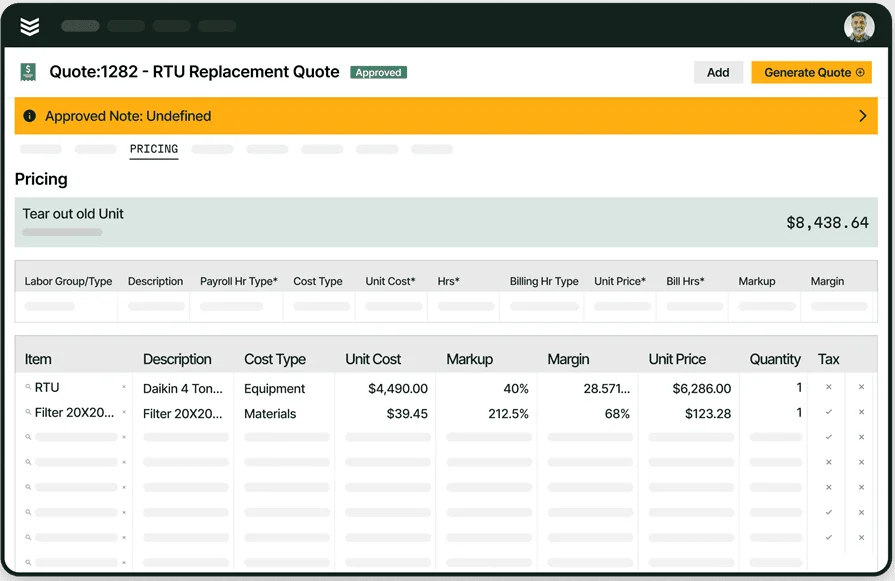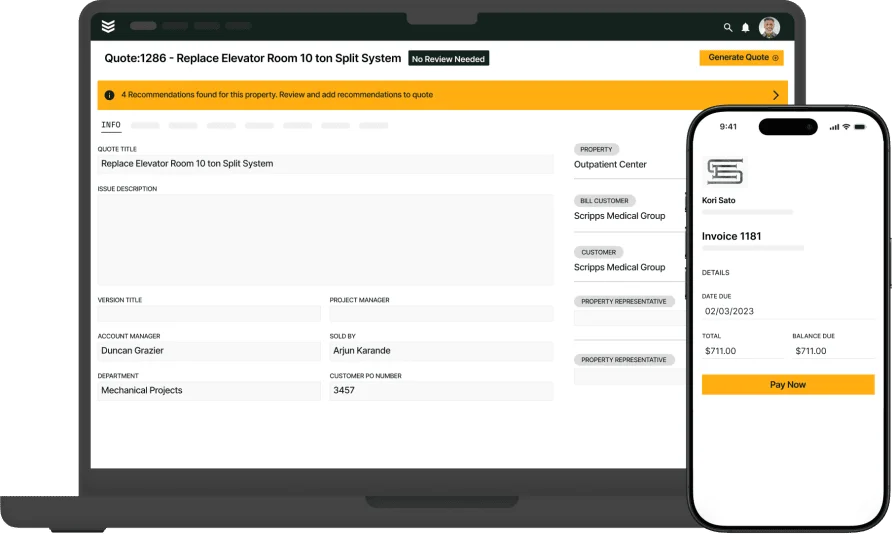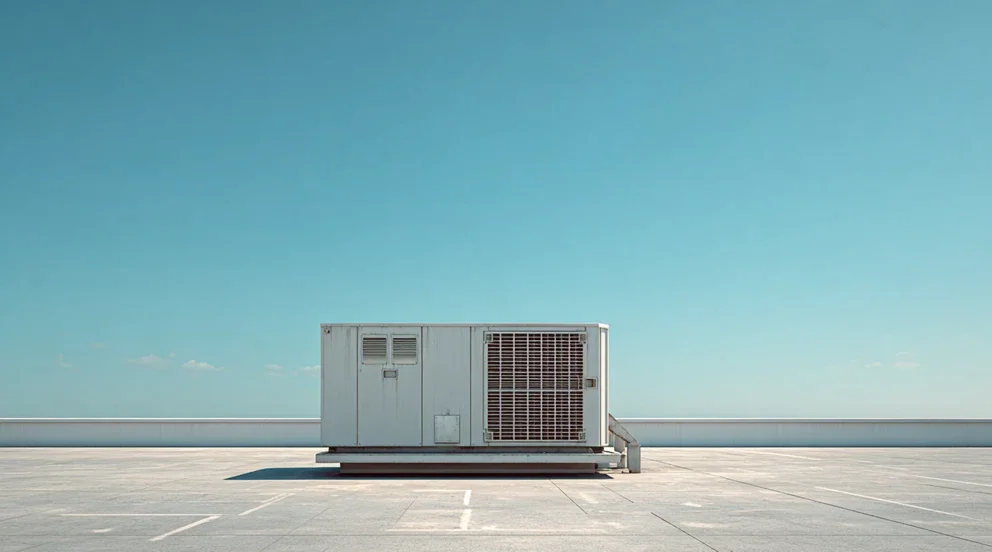When you're pricing out HVAC jobs, guesswork doesn't cut it. You need a system that gives your customers clarity while helping your techs move faster and get paid quicker. That’s where HVAC flat rate pricing comes in.
Instead of calculating time and materials for every job, this method lets you charge a fixed rate for common services—think AC tune-ups, ductwork repairs, or furnace inspections. It makes quoting easier in the field, avoids payment disputes, and builds customer trust right from the start.
This guide breaks down how flat rate pricing for HVAC contractors works, what to watch out for, and the tools that help make it work. If you're serious about tightening your operations in the HVAC industry, this is for you.
- How do HVAC flat rate pricing models work?
- What are the alternatives to a HVAC flat rate pricing model?
- What goes into flat rate pricing for HVAC services?
- 4 flat rate HVAC service pricing examples and templates
- Top 5 HVAC flat rate pricing tools & services
- 6 reasons pricing-integrated HVAC software beats manual flat rate pricing
HVAC techs work in unpredictable environments—older systems, tight crawl spaces, emergency calls in the middle of the night. Flat rate HVAC service pricing gives your team a steady baseline. But before you roll it out, you’ve got to understand how it really functions in the field.
How do HVAC flat rate pricing models work?
HVAC flat rate pricing assigns a set price to specific services—like unit installation, system diagnostics, maintenance, or repairs—regardless of how long the service takes or what materials are used. It gives customers upfront clarity and simplifies quoting for your technicians in the field.
To make it work, you’ll need to base those fixed prices on real averages: how long jobs typically take, common material costs, and overhead like fuel, insurance, and admin time. Done right, flat rate pricing for HVAC contractors speeds up decision-making, limits pricing disputes, and protects your margins—even when the job throws a curveball.
Advantages of flat rate pricing and how it helps HVAC techs
Flat rate pricing in HVAC gives you a clean, consistent way to price services. It’s easy to explain, makes field quoting faster, and helps avoid back-end billing issues. Here’s how it benefits both your team and your customers:
- Makes sales simpler and quicker – Offering a flat rate quote on the spot helps close jobs faster. It saves your team time and lets them focus on service—no back-and-forth or confusing breakdowns.
- Builds customer trust – Clear pricing without hidden fees makes it easier for customers to say yes. They know what they’re paying up front, which boosts satisfaction and increases the chances of return business.
- Encourages efficient work – When techs know the average time expected for each job, they can stay focused and hit targets. That keeps schedules tight and crews moving.
- Simplifies invoicing – Fixed pricing takes the guesswork out of billing. It makes it easier for techs to quote and for customers to understand what they’re being charged for—something that’s reinforced in any solid process, like those outlined in a typical HVAC invoicing guide.
- Reduces pricing conflicts – With flat rates, you’re not arguing over labor time or material markups. Customers see a single price up front and are less likely to push back when the invoice hits.
Disadvantages of flat rate pricing for HVAC techs and where it falls short
Flat rate HVAC service pricing keeps your numbers consistent, but it doesn’t always reflect the reality on-site. System age, hidden issues, or shifting material costs can throw a wrench in even the best estimates. Here’s where it can fall short:
- Risks losses due to unexpected expenses – HVAC jobs often uncover issues that weren’t obvious at first—cracked ductwork, poor insulation, or surprise refrigerant leaks. These can stretch labor time, burn through materials, and cut into your margin. You end up covering costs that weren’t baked into the price.
- Vulnerable to price changes for materials – If coil prices spike or filter costs double, your flat rate won’t flex to cover the gap. On the flip side, if prices drop, your rates might start looking steep compared to competitors. Sticking to a static price in a fluctuating market can put you at a disadvantage.
- Customers may feel they’re overcharged for small jobs – A quick capacitor swap or basic diagnostic might carry the same flat fee as a more involved service. Even when the rate is fair from a business standpoint, it might not match a customer’s expectations. This can lead to questions around value.
- Doesn’t account for variable work conditions – Not all HVAC work is equal. Some systems are easy to access; others are buried in attics, closets, or behind drywall. A fixed rate doesn’t always reflect the time or hassle it takes to do the job right.
- Can lead to shortcuts and rushed work – Flat rates can push techs to race through jobs to stay profitable. That’s where quality can slip. If corners get cut, it shows up later in callbacks and warranty claims. Getting it right ensures you’re quoting smart and protecting profit.
What are the alternatives to a HVAC flat rate pricing model?
If HVAC flat rate pricing doesn’t fit how you operate—or if it’s falling short in the field—there are several other pricing models contractors use to stay competitive and profitable. These are some of the most common across HVAC service work:
- Cost-plus – You calculate the full cost of labor, materials, and overhead, then add a markup. You protect your margins, but customers may question whether they’re getting a fair deal if prices shift mid-job.
- Hourly – Charge based on labor time. It reflects the true time commitment for complex installs or diagnostics, but can lead to drawn-out jobs if not managed carefully.
- Time and Materials (T&M) – Similar to hourly, but you also bill directly for parts used. This gives customers a breakdown of everything going into the job, though it may be tough to quote in advance.
- Tiered service levels – Offer customers multiple pricing tiers (like “Basic,” “Pro,” and “Premium”) with increasing levels of service or upgraded materials. It gives them flexibility while helping you upsell.
- Subscription-based – Customers pay a recurring fee for routine maintenance or priority service. This is especially useful for commercial clients needing seasonal checks or faster response times.
- Value-based – You price the job based on what it’s worth to the customer—not just your inputs. It requires knowing what your market values and how your work stacks up against others, but can lead to better profit alignment long-term.
What goes into flat rate pricing for HVAC services?
Flat rate HVAC service pricing means customers pay a set amount for the job—no matter how long it takes or how much it costs you in parts. But those rates still have to cover your actual business expenses. Here are the most common cost factors that shape flat rate pricing for HVAC contractors:
- Time/labor – You're not just charging for the work—you’re covering time your crew could spend on other jobs. Skilled labor needs to be priced like it’s worth something.
- Parts, units, and materials – From compressors to capacitors, anything you install, replace, or use on the job has to be paid for up front. That includes the cost of stocking truck inventory.
- Travel – Rolling your truck out to a job site burns fuel, racks up miles, and eats time. You’re also covering vehicle maintenance, licensing, insurance, and downtime between calls.
- Equipment usage – Some HVAC jobs require lifts, recovery machines, or specialized tools. Whether you own or rent them, you’re paying to use and maintain that gear.
- Emergency response – When a system fails in extreme heat or cold, customers want help now. Rapid response calls pull techs off other jobs and throw off your schedule—your pricing should reflect that.
- Unexpected project costs – Clogged lines, failed components, or hard-to-access installs can all drag a job out. Flat rate pricing has to account for the stuff you didn’t see during the quote.
- Overhead – Your business runs on more than tools and vans. You’ve got office rent, software, insurance, admin time, and marketing to cover, too.
- Taxes – Most of what you charge or purchase gets taxed, which cuts into your take-home if you don’t factor it in when building your rates.
All these costs are why building out a detailed, well-maintained HVAC price book matters—and why so many shops rely on resources like a professional HVAC price book to keep things consistent and accurate.
4 flat rate HVAC service pricing examples and templates
Flat rate HVAC pricing can vary by region, service type, and job complexity. But if you’re building out your price book, these examples and tools can give you a strong head start—without starting from scratch.
1. Best HVAC software with built-in flat rate templates: BuildOps
BuildOps gives commercial HVAC shops more than just pricing and invoicing—it connects your entire job cycle from first quote to final payment. It’s built to handle the complexity of commercial projects while simplifying everyday tasks in the field. With customizable invoice templates, flat rate HVAC service pricing gets faster to quote and easier to explain. You can also break down material, labor, and service line items for clarity, then sync it all with your accounting software.
- Format: Software
- Cost: Book a live or on-demand demo for details
- Key feature: AI pulls data from field reports and builds invoices instantly

Built-in flat rate pricing
From quote to invoice to payment—all in one tool.
2. Best free HVAC invoice template download: QuickBooks
Image Source: QuickBooks
QuickBooks is a well-known tool in accounting, and their free HVAC invoice template offers an easy way to get started—even if you’re not using their full software. It includes pre-set formulas and fields to calculate totals, taxes, and itemized work. You’ll have to enter each job manually if you’re not connected to QuickBooks, but the layout is clean and professional for printing or emailing right away.
- Format: Software, Word, Excel, PDF
- Cost: Free
- Key feature: Auto-calculates costs in an editable layout
Download the QuickBooks HVAC invoice template and start customizing it for your most common flat rate jobs.
3. Best editable HVAC doc & spreadsheet template: Legal Templates
Image Source: Legal Templates
Legal Templates provides downloadable HVAC invoice documents in both Excel and Word formats. You can either manually edit them or use the guided online builder to fill out your info step by step. It also allows for e-signatures and extra custom fields.
- Format: Excel, Word, PDF
- Cost: Free (with optional paid upgrade)
- Key feature: Walkthrough wizard for invoice creation
Grab the Legal Templates HVAC invoice here to start building your own flat rate form.
4. Best HVAC invoice template library with color variants: InvoiceOwl
Image Source: InvoiceOwl
InvoiceOwl offers a wide range of HVAC-specific invoice templates in multiple styles and file formats. Each one includes space for branding, job IDs, service breakdowns, and total costs. They’re especially useful if you want flat rate pricing to reflect your brand identity without creating templates from scratch.
- Format: Word, Excel, Google Doc, PDF
- Cost: Free basic access, with upgrades available
- Key feature: Multiple design layouts and easy customization
Browse InvoiceOwl’s HVAC invoice templates and pick one that fits your brand and workflow.
Top 5 HVAC flat rate pricing tools & services
If you're ready to build or overhaul your flat rate HVAC service pricing system, the right tool can save time, boost accuracy, and reduce errors. These HVAC-specific platforms and services are built to support pricing, quoting, and job execution in the field:
1. Best HVAC software with estimating included: BuildOps
BuildOps is field service management software built for commercial HVAC teams handling large-scale and high-volume projects. It logs full service history, pulls up site-specific notes, and includes a searchable equipment catalog that plugs directly into your quotes. Techs can snap photos, record field notes, and create estimates without leaving the job.
How It Helps with Flat Rate Pricing: Create detailed, field-ready quotes by turning technician notes into itemized estimates using built-in AI tools.

Explore our pricing product
We connect pricing to invoicing, field reporting, and job closeouts.
2. Best flat rate HVAC price book builder: FieldEdge
Image Source: FieldEdge
FieldEdge is known for its simple, mobile-friendly platform that supports flat rate HVAC pricing through real-time estimating, quoting, and invoicing. It’s especially handy for techs in the field who need to look up pricing, parts, or customer details quickly. However, it may not offer the depth or customization required for large commercial workflows or detailed job costing.
How It Helps with Flat Rate Pricing: Features intuitive estimating and proposal tools that help teams quote quickly without missing key cost elements.
3. Best HVAC app for residential flat rate pricing: Housecall Pro
Image Source: Housecall Pro
Housecall Pro offers a streamlined, mobile-first experience geared toward residential HVAC contractors. It lets you manage flat rate pricing, customer communication, quoting, scheduling, and payment—all from the app. It’s a fast, lightweight solution, but less suited for multi-crew or complex commercial operations that need broader oversight.
How It Helps with Flat Rate Pricing: The mobile design allows quick quote generation and billing based on flat rate templates, without desktop support.
4. Best for solo or small HVAC teams: Jobber
Image Source: Jobber
Jobber is a good pick for smaller HVAC shops or solo techs. It includes quoting, job tracking, scheduling, and invoicing in a user-friendly interface. But if you’re scaling fast or managing multiple teams, Jobber’s lightweight setup may not meet long-term operational needs.
How It Helps with Flat Rate Pricing: Offers simple flat rate quote creation with quick scheduling and easy invoice handoff.
5. Best for multi-trade and complex project pricing: Aptora
Image Source: Aptora
Aptora’s Flat Rate Plus software was designed for contractors managing HVAC alongside plumbing, electrical, or other trades. It supports tiered price books, cost analysis, and in-depth financial tracking. Because it leans toward enterprise-level functionality, it may be overwhelming for smaller shops or those without dedicated admin support.
How It Helps with Flat Rate Pricing: Built for deep customization, it lets HVAC businesses manage flat rate pricing alongside more advanced service models.

91% say bidding is more competitive than ever
According to contractors we surveyed. See what else they had to say.
6 reasons pricing-integrated HVAC software beats manual flat rate pricing
Managing flat rate HVAC service pricing by hand creates room for mistakes, slows down your crew, and disconnects pricing from the rest of the job. Integrated software brings everything together—pricing, quoting, dispatch, billing—so your team works faster, cleaner, and with fewer headaches. Here’s why it outperforms manual systems across the board:
1. Automated price updates
With software, you don’t need to rewrite your entire price book every time something changes. You can set rules to automatically adjust pricing when material costs shift, labor rates go up, or new services get added. This keeps your rates accurate without slowing down your quoting process or requiring constant manual edits.
2. Use past jobs to price smarter
Job history becomes an asset when your system tracks how long services take, which techs handled them, and what parts were used. Over time, you build a reliable baseline for common flat rate tasks. Software that supports HVAC quoting uses this historical data to sharpen your estimates and help avoid underpricing.
3. Analyze pricing performance
Software doesn’t just store prices—it shows you how well those prices are performing. You can compare profit margins across service types, spot slow-paying job types, or see if a specific rate leads to higher close rates. That level of visibility is tough to pull off with spreadsheets alone.
4. Link pricing to your full job cycle
In an integrated system, flat rate pricing isn’t siloed. It flows straight into technician workflows, scheduling tools, customer-facing quotes, and invoices. If your team is already using HVAC scheduling and dispatching tools, tying in your pricing eliminates double entry and keeps everyone working off the same numbers.
5. Flag billing issues early
When pricing is tied directly to job reports and field notes, it’s easier to catch errors before the invoice goes out. If something was added or missed during the job, the software can flag it in real-time—avoiding customer disputes down the road. This level of billing accuracy is one of the benefits outlined in the HVAC billing guide, especially for teams managing high job volume.
6. One system for everything
Instead of juggling one tool for quotes, another for scheduling, and a third for invoicing, everything runs through a single platform. Pricing stays consistent, data flows automatically, and your team isn’t wasting time switching systems. This all-in-one approach is part of why best-in-class HVAC software is quickly becoming standard for commercial contractors who want to run leaner and work smarter.
Flat rate pricing gives HVAC contractors a way to bring structure to unpredictable work. It helps techs quote fast, invoice clean, and stay consistent from one job to the next. But building that system takes more than a spreadsheet—it takes real-world data, cost awareness, and the ability to adjust as your business grows.
That’s where integrated software proves its value. It connects pricing to the rest of your operation, flags issues before they hit the invoice, and helps your team make smarter decisions in the field. Whether you're running a few trucks or managing large-scale commercial accounts, software takes the pressure off your team—and puts control back in your hands.

Want to see BuildOps in action?
Drive profits with a tool that helps you price projects accurately.







